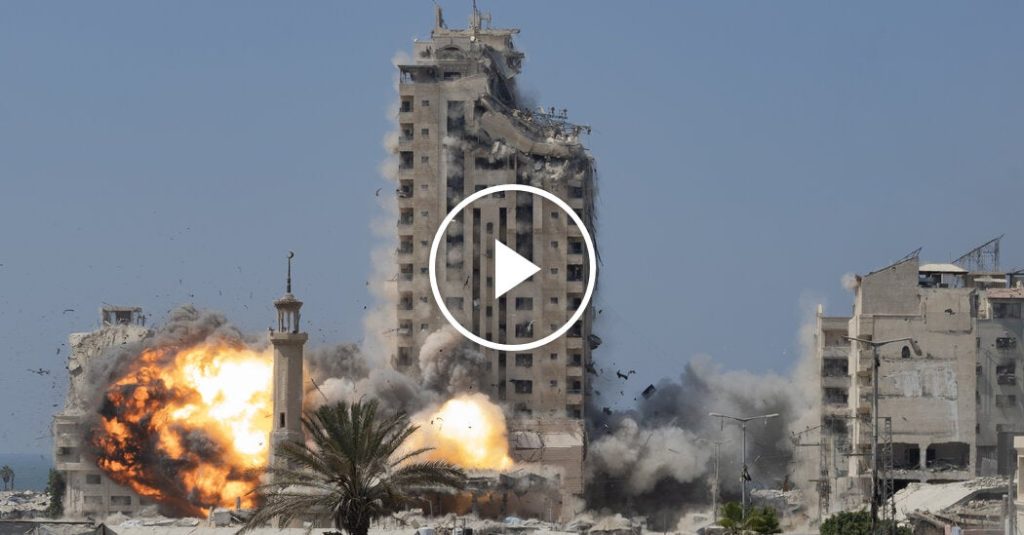Inside Gaza: Mushtaha Tower Destruction Marks Escalation in Israel’s Military Campaign
Historic Landmark Falls as Conflict Intensifies in Densely Populated Urban Center
The thunderous explosion that reverberated across Gaza City yesterday signaled not just another strike, but the calculated destruction of one of the area’s most recognizable structures. The Mushtaha Tower, a prominent architectural landmark that had long defined the city’s skyline, was reduced to rubble as Israel’s military campaign entered what appears to be a new, more aggressive phase. This targeted demolition comes just one day after military officials announced they had established control over approximately half the city, marking a significant territorial claim in the ongoing conflict that has captured international attention and sparked humanitarian concerns across the globe.
The tower, which had stood as a symbol of urban development in the densely populated coastal enclave, collapsed in seconds after what witnesses described as a series of precision strikes. Local residents reported receiving evacuation warnings approximately one hour before the bombardment, though humanitarian organizations have questioned whether this provided sufficient time for the building’s occupants and those in surrounding areas to reach safety. “We heard the warning messages coming through phones and loudspeakers,” explained Mohammed Khalil, a shopkeeper who operated a business several blocks from the tower. “There was immediate panic. People were running in all directions, trying to gather whatever belongings they could carry.” The destruction of such a significant civilian structure raises critical questions about targeting protocols and the protection of non-military sites under international humanitarian law.
Strategic Objectives and Military Control Claims
The Israeli military defended the operation as part of its broader strategic objectives, claiming the building had been utilized for purposes that threatened security. In a statement released following the strike, military spokesperson Colonel Avichay Adraee indicated that intelligence had confirmed the presence of “command and control infrastructure” within the building, though specific evidence supporting this assertion has not been made public. Military analysts note that urban warfare presents complex challenges for conventional forces, particularly in distinguishing between civilian and military targets in densely populated environments where traditional boundaries between combatants and non-combatants often blur.
This latest development coincides with the military’s announcement that it now controls approximately 50 percent of Gaza City’s territory, a claim that represents significant progress in its stated operational objectives. “Our forces have secured critical junctions, thoroughfares, and neighborhoods throughout the northern and eastern sectors,” stated Lieutenant General Herzi Halevi during a press briefing at military headquarters. “This methodical approach allows us to dismantle hostile infrastructure while attempting to minimize civilian casualties.” Independent verification of these territorial claims remains difficult, as international journalists face severe restrictions on access to active conflict zones within Gaza. Satellite imagery analyzed by independent monitoring organizations confirms substantial changes to the urban landscape but cannot definitively establish control patterns on the ground.
Humanitarian Impact and Civilian Displacement
The destruction of the Mushtaha Tower epitomizes the wider humanitarian crisis unfolding across Gaza, where essential infrastructure continues to deteriorate under sustained military pressure. The building housed not only residential apartments but also several medical offices, small businesses, and a branch office of an international aid organization, according to local sources. Its destruction therefore represents not merely a physical loss but the elimination of vital services for an already vulnerable population. United Nations humanitarian coordinator Sara Bennington described the situation as “increasingly untenable” for civilians, noting that the destruction of mixed-use buildings further compromises access to essential services.
Displacement figures have reached alarming levels, with the UN Relief and Works Agency (UNRWA) reporting that over 70 percent of Gaza’s population has been forced to relocate at least once since hostilities escalated. Many families have moved multiple times, seeking safety in increasingly crowded shelters where basic necessities including clean water, food, and medical supplies remain scarce. “We’re witnessing a population in perpetual flight,” explained Dr. Ibrahim Nasser, who coordinates emergency medical services in the central Gaza region. “The psychological impact of constant movement, combined with the physical dangers of relocating during active conflict, creates compounding trauma that will affect this population for generations.” Health officials report that overcrowding in designated safe zones has led to outbreaks of respiratory infections and waterborne illness, further straining a medical system already overwhelmed by conflict-related injuries.
International Response and Diplomatic Efforts
The international community’s response to the escalating situation remains fragmented, with regional powers and global institutions struggling to establish a unified position. The United Nations Security Council convened an emergency session following the destruction of the Mushtaha Tower, though disagreements between permanent members prevented the issuance of a binding resolution. Secretary-General António Guterres released a statement expressing “profound concern” over the targeting of civilian infrastructure and calling for “immediate de-escalation to prevent further catastrophic humanitarian consequences.” Meanwhile, humanitarian organizations including Médecins Sans Frontières and the International Committee of the Red Cross have intensified calls for protected humanitarian corridors to facilitate the delivery of critical supplies.
Diplomatic initiatives continue on multiple fronts, with regional mediators working to establish parameters for a potential cessation of hostilities. Sources familiar with these negotiations indicate that significant obstacles remain, particularly regarding security guarantees and post-conflict governance structures. “We’re witnessing extremely complex diplomatic maneuvering,” explained Dr. Nadia Khalidi, senior fellow at the Center for Strategic and Regional Studies. “Each party has established what they consider non-negotiable positions, creating a challenging environment for effective mediation.” Public opinion in countries allied with both sides continues to evolve, with demonstrations supporting both Israeli security concerns and Palestinian civilian protection taking place in major cities worldwide. This international dimension adds further complexity to conflict resolution efforts, as domestic political considerations increasingly influence diplomatic positioning.
Long-term Implications for Urban Reconstruction and Regional Stability
As military operations continue and structures like the Mushtaha Tower disappear from Gaza’s landscape, questions regarding post-conflict reconstruction loom increasingly large. Urban planning experts estimate that rebuilding destroyed infrastructure could require decades and billions in international assistance, even if hostilities were to cease immediately. The targeted destruction of landmarks and multi-use buildings creates particularly complex reconstruction challenges, as these structures often serve as anchors for surrounding commercial and residential development. “When you lose a building like Mushtaha Tower, you’re not just losing the physical structure,” explained urban development specialist Helena Rodriguez. “You’re losing a nexus of economic activity, social interaction, and community identity that cannot be easily recreated.”
The broader regional implications of the current conflict phase remain difficult to predict, though security analysts suggest that the destruction of civilian infrastructure could complicate long-term stability efforts. Historical patterns indicate that large-scale urban destruction often creates conditions conducive to prolonged insurgency and generational grievances. International reconstruction efforts would require unprecedented coordination between global donors, regional stakeholders, and local communities to address not only physical rebuilding but also social and economic rehabilitation. As the dust literally and figuratively settles on landmarks like the Mushtaha Tower, the path forward appears increasingly complex, requiring sustained international attention long after the current headlines fade. For residents of Gaza City, the altered skyline represents not just physical transformation but a fundamental reshaping of community life that will define their reality for years to come.











